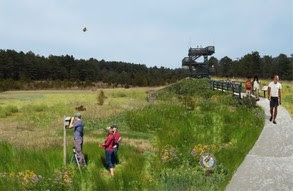Toms River Mayor Maurice “Mo” Hill released a statement this evening in support of the proposal announced earlier this week by the New Jersey Department of Environmental Protection regrading the site of the former Ciba-Geigy Superfund Site in Toms River.
“Preserving 1000 of open space is great news for the residents Toms River who are all concerned by the impact of overdevelopment on the quality of life in our community,” Mayor Hill said.
“So long as the pollution has been successfully remediated, making the site safe for public access, the proposed nature preserve, park, trails, a boardwalk, and environmental center would be would be a great enhancement for our residents and a potential boom to our tourism industry,” he added.
The former Ciba-Geigy chemical plant began manufacturing industrial dyes, pigments, resins, and plastics in 1952.
In 1983, the site was listed on the National Priorities List as an EPA-lead Superfund Site due to significant contamination of soil and groundwater resulting from improper chemical waste disposal. Plant operations ceased in 1990.
Under the proposal, approximately 1,000 acres would be permanently preserved for the benefit of the public, with hundreds of acres to be restored through a variety of ecological improvement projects.
When complete, the site will feature public access, passive recreation, and natural resource interpretative and educational opportunities.
The Mayor, however, made several requests from the state, including an appeal for an exhibit detailing the damage caused to the community, as well as fund to compensate victims.
- Given the devastation that Ciba-Geigy’s cancer cluster wreaked on Toms River families, the proposed environmental center should be required to include an exhibit that comprehensively documents the damage the pollution caused to our environment, the health of our residents, and the negative economic impact on our community. A committee of academics, environmentalists and Toms River residents should be appointed to create and maintain the exhibit. The exhibit should be generously funded by BASF.
- The remaining 255 acres of the site, or a significant portion thereof, should be deeded to Toms River Township for perpetual preservation, so long as BASF remains responsible for the cost of ongoing remediation.
- A fund to compensate the victims of the cancer cluster should be set up by BASF and administered by a trustee appointed by the Township.
In addition to walking, running, hiking, opportunities for the public, an environmental education center will be constructed to provide natural resource interpretation programs for the public.
The project could break ground in the spring of 2023, become open to the public in phases, and be complete within the next five years.
“I urge all Toms River residents to support these proposals, and to make their own comments during the 30 day comment period,” Hill added.
Public comments can be made here: https://www.nj.gov/dep/


It is nearly impossible to truly clean up such an environmental mess.
It probably is for the best that it should not be used as a residential area or anything that will have children there long stretches of time. ( probably adults too)
For those of you who are lacking context, this site housed in massive chemical plant from the 1950s through the 1990s.
Hundreds, if not, thousands of tons of highly toxic contaminants were spilled and leached into the ground and groundwater.
This affected groundwater for tens of thousands of nearby citizens, and has been scientifically linked to the rise in childhood cancer in the area.
There is a compensation fund in place to help victims, although I do not know what their requirements or the the compensation is.
Although they are considering a park in about a 200 acre area of the site, over 1,000 acres are still undergoing remediation.
The German company won $20 million in a court decision against the residents of Toms River to pay for the devaluation of the land it owns here, which was only devalued because of the company’s decades-long practice of dumping harmful cancer-causing chemicals.
BASF has challenged the township in court and filed a tax appeal, which it won, putting the townspeople in a community devastated by toxic water for decades in the unlikely position to have to pay the corporation $20,000,000.
That $20 million refund the township is about to give BASF would have years of negative impact on taxes in the town. This year alone, taxes in the township are going up 7%. Township officials did say they intend to appeal the court’s ruling. If forced to pay the full $20,000,000, future tax increases can be up to two times higher in the coming years.
According to a 2001 report by the State of New Jersey Department of Health, increased mortality from lung cancer was also observed among former maintenance workers at the Toms River Plant, and stomach and central nervous system cancers among azo dye production workers at the Toms River Plant. A recent update of this study, with additional years of follow-up of former workers, generally confirmed the earlier findings.
Water in nearby neighborhoods were contaminated with deadly chemicals, chloroform, Benzene, Trichloroethylene and Tetrachloroethylene, all of which are carcinogens. Cardinal Drive and Oak Ridge Parkway were hit hard, according to the report, confirming the presence of an excess of childhood cancers in the community.